Baranof Blog & Fishing News
- Home
- Baranof News Blog
- Archives
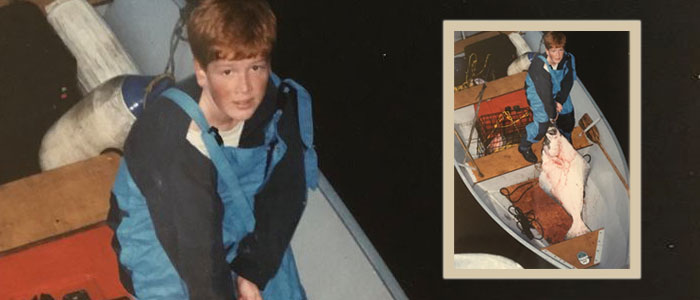
By Greg Slagle
AJ knows every nook and cranny of the area surrounding Ketchikan. His boat handling skills are renowned, as he has traveled most of Southeast Alaska in small skiffs during his trapping, fishing and hunting adventures. Out of all of Baranof’s guides, AJ probably has the most eclectic and interesting stories of outdoor living in Alaska: he has guided on the Nushagak River in the Bristol Bay drainage hunting caribou and moose; chased mountain goats and Sitka black tail deer through the hillsides in Southeast Alaska; led brown bear hunters through the wilderness of the Misty Fjords National Monument; and caught halibut and king salmon off the coast of Prince of Wales Island. For a time, AJ ran a large fishing live-aboard called the Shamrock. He’d take clients out for multi-day salmon and halibut fishing charters in the Ketchikan area. On one such trip, when I was about ten, I was allowed to join him as a deck-hand. This was an absolutely amazing experience for me as a child, part of which AJ chronicled on his Facebook account recently after coming across an old photo:
"Hey AJ, Greg's got something big on up on the bow" the client said to me as I was cooking dinner for everyone. I had him watch the meal cook while I went and checked it out. When I hefted the rod after arriving there I said "Greg, go back to the stern and I will hand it down to you, and grab my pistol as you go by." He raced belowdeck yelling as he ran "oh boy!,I got one big enough to shoot!" It went well. Greg did exactly as I asked and brought the fifty-pound halibut to the surface and I shot it before bringing it into the skiff we had tied off. It was a great moment to see his joy and wonder at what he had caught. I wish I could have brought my young nephews and nieces on more of those excursions, but I am glad Greg got to come along on that one. That halibut is one I won't forget...
…and neither will I. Our father made sure that my brother and I spent as much time with AJ working, fishing, and hunting as we could while growing up, and he taught us a great many things; the most important of which is our love and respect for the Alaskan outdoors.
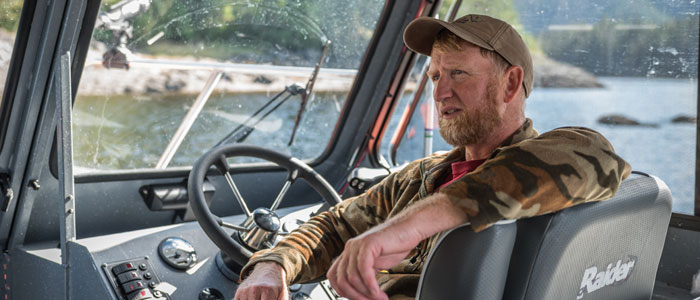
By Greg Slagle
In August of 2017, I took a trip back to Ketchikan with my middle child and oldest son, Charlie. During our visit, we had the opportunity to join my uncle AJ for a day out on the water in Baranof’s newest Raider cabin cruiser, the 30 ft. Alyssa. Ready to do some halibut and salmon fishing anywhere near Ketchikan that AJ wanted to go, he opted to run us down to his old stomping grounds near where he used to fish for Mink Bay Lodge. My son thought the day was about fishing. While he was technically correct, my goal for the day was to provide him with the rare experience of spending time in the Alaskan wilderness with a true master outdoorsman.
A born-and-raised Alaskan, AJ spent his formative years hunting, fishing, and trapping from his family’s home, a floating logging camp located northwest of Ketchikan in Neets Bay. If a biographer were to write about AJ’s experience in the Alaskan outdoors, I can assure you it would most likely be to the tune of been there, done that. While many people talk about a desire to live comfortably by themselves in the wilderness, few really enjoy their own company enough to do so; AJ is one of the rare outdoorsmen that could spend three weeks solo in the woods, and not get lonely.
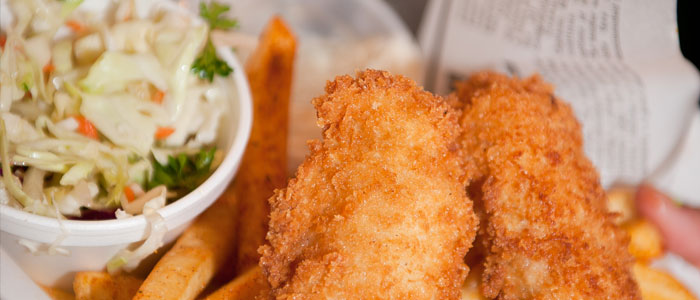
Visitors to Ketchikan, and the rest of Alaska, are sometimes surprised to find we use American currency. While we do live a life disconnected from the “Lower 48s”, we’ve been a part of the U.S. of A. for a long while now. In an effort to solidify Alaska’s inclusion in this great country of ours, we at the Alaska Fish House have decided to spotlight our most popular dish; Fish & Chips. Sure, the combination of fried fish and fried potatoes is over a hundred years old and one of a multitude of things we “borrowed” from our British cousins, but nobody deep-fries like we do. From okra to butter, anything a patriot has been able to get batter to cling to has been boiled in oil and chewed off a stick. Thumbing our noses at the tyranny of the pervasive medical propaganda, much like our forefathers did toward taxation without representation, the Alaska Fish House is proud to prove its unwavering national pride by wrapping Alaska’s freshest fish in two layers of bread and dunking it in molten peanut extract.
All kidding aside, we’re not as gung-ho about deep-frying as we pretend. Fresh Alaska seafood, especially salmon, is rich in natural flavor. Rather than covering it up with a lot of seasoning, ingredients that accent the flavor of the meat are our preferred method of preparation. Our menu is replete with options with an eye toward natural, healthy flavors such as our steamed crab or blackened halibut tacos. Whether you’re in the mood for something savory, healthy, or a little of both, the Alaska Fish House is here to satisfy.
To view, more recipes from the Alaska Fish House go here
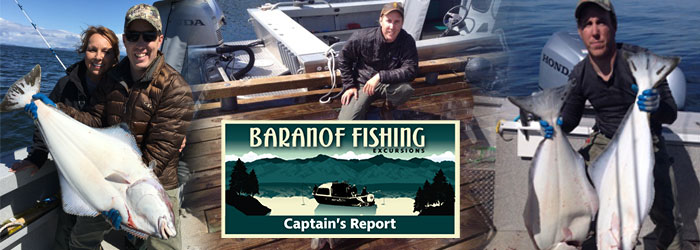
This has been an interesting year for anyone trying to follow the upcoming changes to charter halibut limits for 2018. The International Pacific Halibut Commission (IPHC) has been uncharacteristically deadlocked in determining halibut size limits for the 2018 fishing season.
In February, a 35-80 inch slot was proposed to keep the numbers within a sustainable range. Halibut over 35” would need to be released. While the sustainability of the fishery is of utmost concern for most fishermen, this cut in size limit would hurt, as lots of the halibut we catch fall within that size range. Fortunately, as of now, the commission has decided on a 38-80 inch slot for 2018, giving Ketchikan charter fishermen an additional three inches.
A three-inch difference might not seem like a lot (it equates to about a 5-pound difference in weight), but it is a big deal. Our average halibut length is around 35”, and a large percentage of halibut we catch fall within the 35”-38” range. If we couldn’t keep fish in this size range, a lot of halibut would be going back this year. This slot limit applies to guided sport halibut charters in area 2C, which is anyone fishing for halibut in Southeast Alaska and includes the Ketchikan area.
Sometimes stricter regulations tick me off; but when that happens, I need to take a step back and look at the big picture. If we don’t protect these fish, they’re not going to be around.
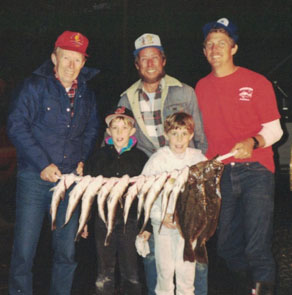
wearing the sweatpants (It was the 90’s).
Halibut have a special place in my heart. My family fished halibut before I was born and some of my earliest memories involved halibut fishing. My first time fishing halibut, my dad, my two uncles, my twin brother and I went halibut fishing out of Marina Delray in Southern California. We were fishing offshore, and though my parents tell me I was conceived on a boat in the same area, it was the first time I can remember being on the ocean. Right from the start, we had a hard time getting our lines to the bottom because a large school of mackerel was ferociously taking the bait on the way down. My brother and I were having a ball catching the little mackeral, but the older generation of fishermen were getting irritated. At one point, I remember my normally mild-mannered dad cursing a mackerel as he smacked it against the side of the boat. My brother and I were overjoyed at the non-stop action; we were catching fish, why was everyone else upset?
This went on for a few hours before we attracted the attention of a giant sea-lion who had learned to follow boats around looking for an easy meal. When the bugger grabbed a mackerel I had pulled out of the school, I had no idea what was happening, I just knew that something tremendous was pulling all my line off the reel. My uncle, knowing right away that I was on my way to getting spooled, immediately cut the line with a knife. They had to explain it to me, I didn’t know what happened.
Later on, amongst the maceral onslaught, I was reeling in another fish and the thing started aggressively pulling line off the reel. I started screaming “Cut the line! Cut the line!”. My Uncle Dave replied, “Screw you.” I was bewildered by the situation, but I started slowly gaining on whatever it was. After what seemed like a very long time, I saw an unusual fish coming up out of the emerald green deep. At that point, I knew it wasn’t another sea lion, and I was amazed when my uncle savagely gaffed it and plopped it on the deck. Everyone but me cheered. So that’s a halibut? I realized that up to that point, I didn’t even know what the heck we were fishing for. I was happy with the mackerel, but this halibut was incredible to me.
We finished the day catching a hundred or so mackerel and a nice pile of sea bass; I caught one more halibut. This time, I knew what it was as it took its first dive and started pulling drag; and I was beside myself with excitement. At the end of the day my brother may have been a little upset that I caught the two halibut of the day and hooked the only sea-lion, but I remember how proud my dad was. When we got the boat cleaned and put away, the entire family met at my grandma's where we celebrated the successful day by frying up our fresh fish.
This was my first experience halibut fishing, my first time hearing my dad swear, and the first time anyone ever said “screw you” to me. It was a monumental day of firsts, and halibut fishing has been in my blood ever since. Twenty-five years later, I still vividly remember the mackerel, the halibut, and the sea-lion; but most importantly, I remember the wonderful time we had as a family. My dad has since passed away, and my uncle has since sold his boat and moved to Arizona; but while life is constantly changing, memories like this always stay with you. For me, this encapsulates the true essence of fishing.
I hope to one day create these types of memories for my children, and it’s our regulations that keep me optimistic. Pacific halibut are fortunate that fishermen have learned from past failures and are applying their knowledge to protecting the halibut population. While there are three distinct species of halibut, (Atlantic, Pacific, and California) only the California and Pacific halibut have steady numbers. Atlantic halibut haven’t been so fortunate. Atlantic halibut are found on both sides of the Atlantic from Virginia to the United Kingdom, but are considered an endangered species due to hundreds of years of unregulated fishing; lessons learned at the expense of this species are being applied to West Coast fisheries, which have made organizations like the IPHC possible.
The International Pacific Halibut Commission (IPHC) is responsible for protecting Pacific halibut from Southern California all the way to the tip of the Aleutian Islands including; Alaska, British Columbia, Washington, Oregon, and California. This is a huge area, but it is only part of the tremendous range of the Pacific halibut. They range down the coast of Russia to the coasts of Japan. While the IPHC doesn’t include Russia or Japan at this point, it does ensure all of the fishing regulations throughout northern America work together to protect the resource. The IPHC is an international treaty amongst Canada and the US making halibut one of the few federally regulated fish in our area.
It’s no surprise to me that outdoorsmen are usually ardent conservationists; we love the wild, and most are fascinated by the vast intricacies of its inner workings. From its lifecycles to the incomprehensible food webs, the wildness of the ocean is something we can touch, feel, and eat. Nevertheless, regulations sometimes feel like a double-edged sword; while they do limit something we love, they also ensure the future of this passion for future generations.
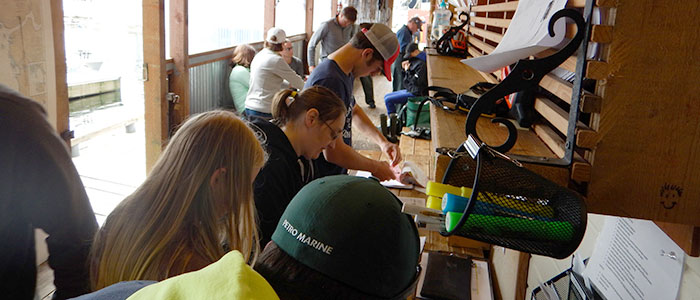
Preparing folks for a day fishing around Ketchikan means adding layers and getting licensed. Bonnie and her crew, along with the guides, do an excellent job of outfitting our guests with everything they need for a day of fishing for salmon and halibut in Ketchikan. Raingear, boots, hats, gloves, socks, dry bag, and life preservers are fitted for each client’s comfort by their guide while the state of Alaska fishing license is filled out for each guest by Bonnie’s team. Nobody goes fishing without a license, so until everyone is legal, Bonnie is in charge; you’ll often see our owner, Chuck, with license book in hand scribbling furiously to avoid Bonnie’s wrath. Once all the boats have left the dock, Bonnie gets to relax in the office settling billing accounts for about 100 guests before the cruise ships leave port. Once the passengers are back on board, she checks the next days counts and starts the whole process over again. Baranof takes thousands of guests fishing in Ketchikan, Alaska during a season, and we couldn’t do it without Bonnie Steinberg.
From the Wheelhouse
Our captain’s report on up-to-date fishing conditions, regulations, and trends.
View Report
Check Back For These Great Upcoming Stories
- Overnight kayaking through the Mistys Fjords
Nothing breaks you into the beauties of the Misty's like a week paddling through her splendor. - SE Alaska 2019 Fishing Regulations
Fishing limits and the Fish & Game’s reasoning, and what it means for Baranof’s guests. - Adventure around Revillagigedo Island
Misty's, Hot Springs, Fishing, Crabbing, and wildlife; the experience of a lifetime.
- February 2024
- April 2023
- June 2022
- March 2021
- February 2021
- March 2020
- February 2020
- January 2020
- December 2019
- October 2019
- August 2019
- June 2019
- April 2019
- February 2019
- January 2019
- November 2018
- October 2018
- September 2018
- June 2018
- May 2018
- April 2018
- March 2018
- February 2018
- January 2018
- December 2017
- November 2017
- September 2017
- August 2017
- July 2017
- June 2017
- May 2017
- April 2017
- March 2017
- February 2017
- January 2017